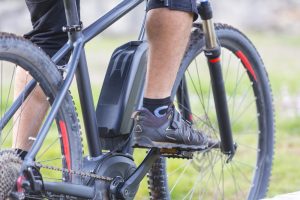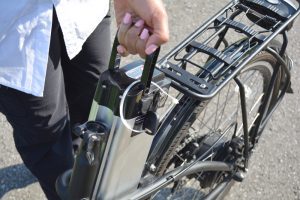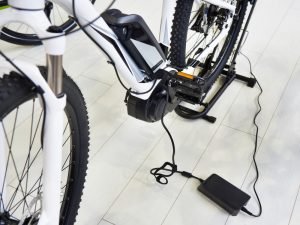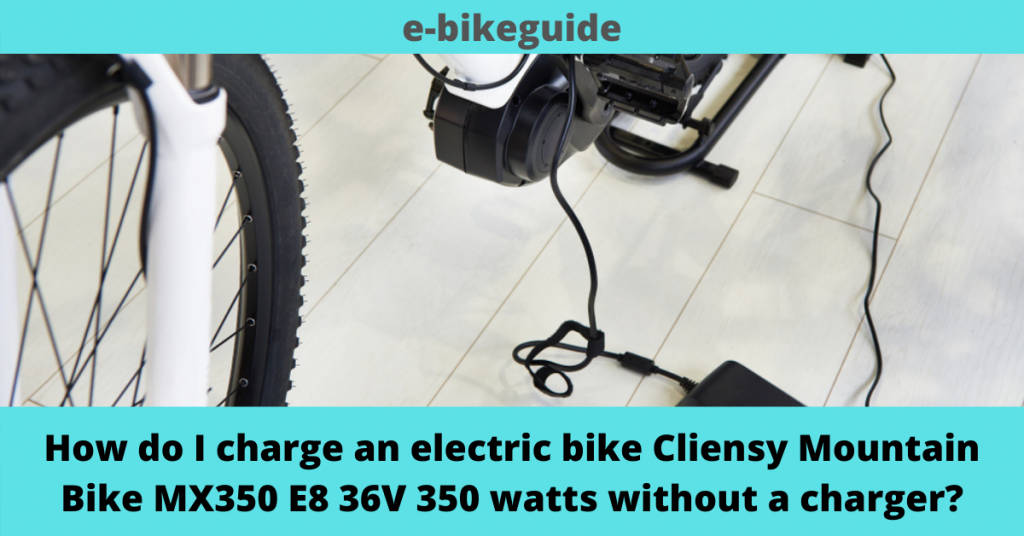How do I charge an electric bike Cliensy Mountain Bike MX350 E8 36V 350 watts without a charger?

What exactly is it about the Cliensy electric Mountain bike that makes them so appealing? The answer to that would be its source of power, or in other words, the battery. It’s no surprise that it’s one of the most vital parts of an electric bike since it powers almost every component of your e-bike, allowing you to embark on the most epic excursions and create unforgettable riding memories. For this reason, it is critical to maintaining your battery’s health. This means you’ll have to make sure it’s properly charged at all times, not overcharged, kept away from water, and so on. When talking about the battery of an e-bike, charging is the most important topic since running out of charge is one of the biggest fears of an e-biker. There are so many questions that arise with this topic like “what if I don’t have a charger?”, “what are the alternative ways to charge my battery?”, “how to take care of my e-bike battery?”, and so on. This article will be discussing all you need to know about charging your e-bike and the safety practices you must follow when doing so.
Charging Your Bike Without A Charger

The powerful 36V 8Ah Lithium battery of the Cliensy e-bike can be dismounted and charged and it has a charging time of 4 to 5 hours. The great thing about its charger is that it has a safe design to prevent overcharge. But what if you don’t have a charger at hand? Running out of charge while on the go is something that can happen to any e-bike rider. The most obvious option is to bring two batteries, but this will add another 5 to 6 Kilograms to your luggage. And, if you bring your charger, you’ll be carrying around an extra few pounds. Check out these alternative ways to charge your electric bike battery so that you can be better prepared and won’t have to wait for someone to come and give your sorry self a hitchhike.

- Use a car battery to charge. This would work if you arrived in a car. But you must be mindful to hook it up properly or else you’ll risk damaging the battery. Furthermore, to do this, you’ll need three things: an inverter to convert the power from the car battery to a voltage compatible with your electric bike battery, a power energy monitor to tell you how much power is flowing from the car battery to the electric bike battery, and an alternator penetration test to make sure you don’t continue to charge and damage your battery.
- Use a Solar panel and a portable battery. If you arrive by car, bringing a solar generator, which can be used in conjunction with the Nomad solar panels, is an excellent option. Amazon offers combo packs for less than $350. Charge it up before you go and then you can use the solar panel to keep it charged when you’re out in the country and don’t have access to electricity.
- On-the-Go Plugging. Bringing a charger and plugging it into a standard wall outlet is the most frequent and straightforward technique for charging an e-bike on the move. While having the largest battery available for more capacity and less on-the-go charging may be desirable, more capacity means more weight and a higher price. Batteries generally account for a significant portion of the cost of most e-bikes, and if your general everyday use does not necessitate a larger battery, the additional cost and weight will likely not be worthwhile having.
Best Practices To Care For Your Electric Bike Battery

Not taking proper care of your electric bike’s battery can result in you having to replace it and that would cost you a big sum. Hence it’s critical to understand how to care for your electric bike battery in order to get the most out of it. When it comes to the life and service of a battery, the two most significant variables are charging and care. A variety of factors influence the performance and thus the range of your electric bike. Terrain, riding style, tire pressure, the weight of the user, and temperature are all factors. Time is also a factor; all batteries degrade over time, whether they are in use or not. You will require more power if the terrain is hilly. Also, the type of surface you’re riding on can have an impact. Batteries don’t like it when they’re stored in extreme heat or cold, or when they’re exposed to a lot of moisture. They also dislike being left in a completely depleted state. Lithium batteries that have been left flat for a long time may no longer be functional.

It takes less effort to maintain a smooth tarmacked surface. It requires more effort to walk on a softer surface like sand or a loose substance like gravel. Because soft tires have increased rolling resistance and drag, keeping them inflated makes a major difference. Tires inflated to the proper pressure will extend the life of your battery. In general, if you’re somewhere where riding a regular bicycle would be difficult, your electric bike’s battery will likely be used more than in less difficult situations. Here are some tips to extend your e-bike battery’s life.
- The Proper Setting
- Charge your battery in a cool, dry, and moderate environment. Never charge in a messy or moist environment where the battery can get wet. Many household mishaps are caused by crowded garages, so if this is a worry, it might be time to do some periodic cleansing or charge the batteries in a far less congested spot.
- Set a timer to make sure you don’t forget to unplug the battery
- Overcharging the battery is one of the reasons for the battery to go bad. You may set a timer with your phone or purchase an outlet timer at any hardware store. When the charger turns green, the battery is fully charged and should be unplugged. Unplug the charger from the wall before disconnecting it from the battery. This wouldn’t be necessary with the Clinsey bike though because its charger has a safety design that prevents overcharging.
- Hibernate mode
- It’s a given that you don’t travel on your bike daily and sometimes you might go weeks or even months without hopping onto your bike. For example, if you’re not cycling during the wintertime, make sure your battery is fully charged and stored inside. When storing, keep your battery at 50% capacity. Because the battery will self-discharge over time if you don’t ride for two months or more, make sure to check the charge every now and then and chargeback up to 50% as necessary.
- Secure traveling
- Electric bikes are an excellent travel partner, but while traveling on a rack or truck bed, remember to remove the battery from the frame using the key. This will save your battery from being tossed around aggressively and getting damaged. Since water can damage your model’s electrical components, use a waterproof cover when transporting it if the weather prediction calls for rain.
- Hold it handy
- The safest method of charging is to connect the charger to the battery first, then to the wall. This prevents arcing by allowing you to make a good connection before electricity flows. All Rehydrated batteries can be charged either on or off the bike; the choice is entirely yours.
- Finishing Touches
- The optimum time to charge your bike is right before you go out for a ride. Never charge your electric bike after a ride because it will be heated up and needs to be cooled down. To allow the battery to cool down, wait at least 30 minutes before charging. And always make sure to check the voltage on your LCD before leaving the house.
Conclusion

The battery of an e-bike is the most important part that gives life to it. If you adore your new Cliensy Mountain bike, make sure you show your affection for the battery by taking care of it. That is, you have to follow the battery care tips discussed above and make sure the battery is charged on time and not allowed to be overcharged. Of course, there can be a situation where you do not have a charger or your charger isn’t functioning. At times like that it would be best to use an alternative method to charge it because if you’re not able to do so for a long time, the battery would end up being damaged and needing replacement. And mind you, battery replacement can be very expensive! So if you take good care of your e-bike’s battery, it will reward you with a longer lifetime and more riding miles in return! To reduce range loss and get the most joy out of your trip, follow the above helpful tips. However, if you are not experienced in the alternative charging aspect of e-bikes and are not educated on the mechanics of it, it’s better to get advice from someone who does know before you meddle with it.
